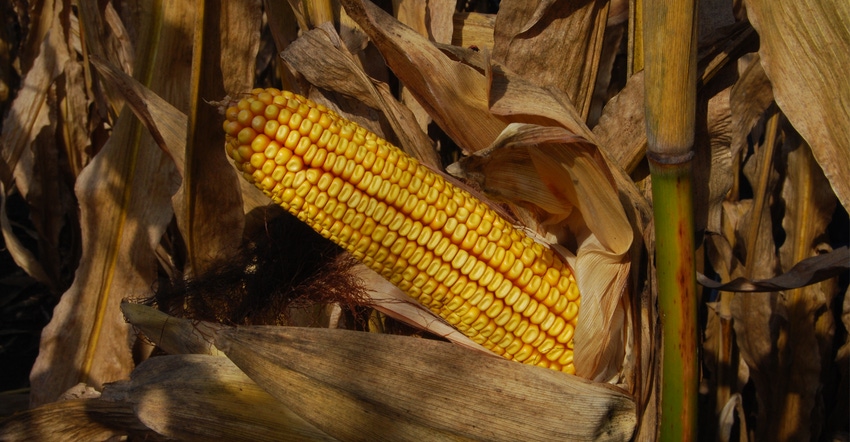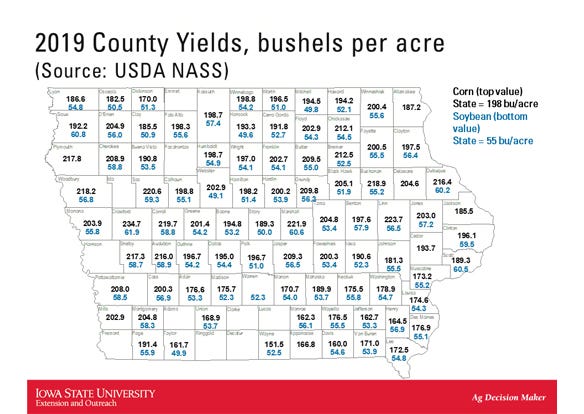March 13, 2020

The 2019 average corn and soybean yields for counties and crop reporting districts in Iowa were released Feb. 20 by USDA’s National Ag Statistics Service each year using the December Agricultural Survey and the County Agricultural Production Survey.
On the Iowa State University Ag Decision Maker website, this data is provided in Information Files A1-12 (corn) and A1-13 (soybeans), “Historical Yields by County,” which show county averages from the previous 10 years by county and crop reporting district.
This information is helpful for seeing trends in yields over the past 10 years. Information File A1-14, “Iowa Corn and Soybean Yields,” also uses this data to show the 10-year average yield, and the year and yield results for the highest and lowest years for each county in the past 10 years. This information is helpful in developing corn and soybean budgets, cash-flow projections or other types of analysis for producers in which the actual production history is not available. The crop yields are reported in bushels per harvested acre.

Operators randomly selected
NASS conducts the December Agricultural Survey each year to establish state and national estimates of row crops such as corn and soybeans. The County Agricultural Production Survey is also conducted each year to collect data that are combined with the DAS data and used to establish the county-level yields. The CAPS survey is conducted at the end of harvest.
Each year, a combined 11,000 randomly selected operators in Iowa are interviewed for these surveys. The farm operator reports the whole farm’s planted and harvested acreage, and yield or production for corn, soybeans and hay. They are also instructed to include acres rented from someone else, but exclude land they rent to another producer. Data for small-grain crops like oats are collected earlier in the year.
The data are collected using several methods: mail, telephone interview, personal interview or the farm operator can even report electronically. Data collection begins in late fall and continues through mid-January. Trained enumerators or census takers collect the data. The same enumerators are used to collect data for NASS year-round. Strict guidelines are followed in all states to ensure comparable results on a national level.
How accurate are reports?
Several steps are taken to verify the accuracy of the reports. The first step is a check for reasonableness, and any questionable results are double-checked with the operator by an experienced NASS statistician. The results are then entered into a secure computer system and checked again for extreme yields and outliers in the data. At this point, the data are ready to be analyzed.
NASS uses a system called Interactive Data Analysis System. With this program, they can graphically look at all data that has been reported in each district and county allowing a geospacial review of the data. During this phase, outliers are once again identified but by district and county and are verified for accuracy with the farm operator.
Once the follow-up on outliers is completed and all data errors are corrected, the data are then summarized by district and county (or point estimates) for acreage planted and harvested, as well as yield. The summary indications are loaded into a tool that displays them along with other sources (administrative data) of county data, including certified acreage data from the Farm Service Agency, crop acres insured from the Risk Management Agency and NASS satellite-based acreage data (cropland data layer). These other data sources mainly help determine planted and harvested acreage, while NASS survey data provide the primary data source for determining yield estimates.
Established estimates are reviewed by the NASS Agricultural Statistics Board in Washington, D.C. This board reviews Iowa estimates as well as other states to check for consistency, adherence to publication standards, and once again for accuracy. After this final review, the acreage and yield estimates are published and made available online.
Some counties aren’t reported
In four out of the last five years, yield information has not been reported for both major crops in all 99 counties in Iowa. Results in these counties were suppressed due to not enough usable responses from farmers. NASS needs responses from at least 30 producers in a county or yield reports for at least 25% of the harvested acreage in a county in order to publish data for that county.
When one county doesn’t have sufficient responses, data from another county in the same district is also withheld so the yield in the county without enough reports cannot be derived. If county yield data is used in a farmland lease or other component on a farm operation, it might be necessary to agree upon a secondary source for yield information if the county yield is not released by NASS in a given year.
Participation in ag surveys such as the December Agricultural Survey and County Agricultural Production Survey is critical for the results to be published across the state. The February NASS report is the best source of long-term yield history available at the county level. The NASS county data is useful for benchmarking your farming operation, tracking yield trends, determining flexible farmland lease arrangements, as well as developing crop budgets and cash-flow projections where the actual production history is not available. In addition, the data are used to support RMA crop insurance programs and FSA farm support, conservation, disaster and loan programs.
Change prompted by farm bill
Under the 2018 Farm Bill, county data from the RMA crop insurance program, rather than NASS, will be used to make farm program payment calculations. That data is publicly released later in the year (typically available when payment information is released in October). It can be found on the FSA website.
Summary information is available on the Ag Decision Maker site at Historical Corn Yields by County A1-12; Historical Soybean Yields by County A1-13; Corn and Soybean County Yields A1-14. For other state or county estimates, including other crops, livestock and farm numbers, visit the NASS website for Iowa.
Johanns is an ISU Extension program specialist, and Thessen is director of the Upper Midwest Regional Office of USDA’s National Agricultural Statistics Service.
Source: NASS, which is solely responsible for information provided and is wholly owned by source. Informa Business Media and all of its subsidiaries are not responsible for any of the content contained in this information asset.
You May Also Like




